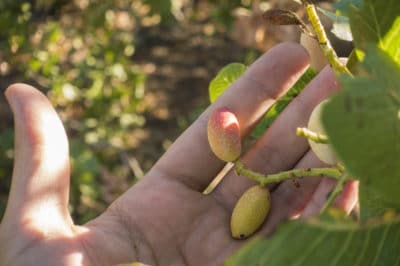The Right Climate
Pistachio trees (Pistacia vera) grow in the parts of USDA plant hardiness zones where winter cold, spring wind and summer heat meet their somewhat temperamental needs:
- Winter must bring 850 or more hours of temperatures between 34° and 45°F (1° and 7.2°C).
- Spring must dry enough to discourage fungal diseases and windy enough for pollen to travel from male to female trees.
- Summer must bring at least 600 hours at 86°F (30°C) or higher.
Soil and Spacing
While they’re very particular about climate, pistachio trees are much less picky about soil. If it drains well and their roots can sink 4 feet deep before hitting hardpan, they’ll tolerate salty, alkaline or rocky soil without complaint. For the heaviest harvests, however, plant them in sandy loam with a pH between 7.1 and 7.8.
Plan on allowing 15 to 18 feet between trees (you’ll need at least one male to pollinate the females). For a large planting, allow 20 to 22 feet between rows.
Sun
As desert trees, pistachios thrive with all-day sun. If possible, grow them where shade is non-existent.
Watering
During late winter’s bud set and early summer’s fruit production, each tree needs about 40 gallons (150 liters) of water every day. From midsummer until harvest, that jumps to 50 gallons (190 liters). Slow, deep watering with a drip irrigation system is recommended.
Feeding for Healthy Leaves
Nitrogen fertilizer fuels leaf growth and leaves fuel nut development. For the lushest leaves, fertilize each tree in early spring with 25 pounds of organic, grass-fed cow or horse manure. Spread it evenly over the soil and water well. Avoid chicken manure, because its high nitrogen content may lead to root burn.
Supplemental Leaf Feeding
Boost young pistachio trees’ vigor with a foliar spray of boron, copper and zinc. During their first three years, apply the spray every three weeks from the time the leaves open until they drop in fall.
After the fourth year, switch to a treating with a zinc and boron foliar spray. Treat the trees at bud break in early spring, when they flower in mid-spring and as they enter dormancy in fall.
